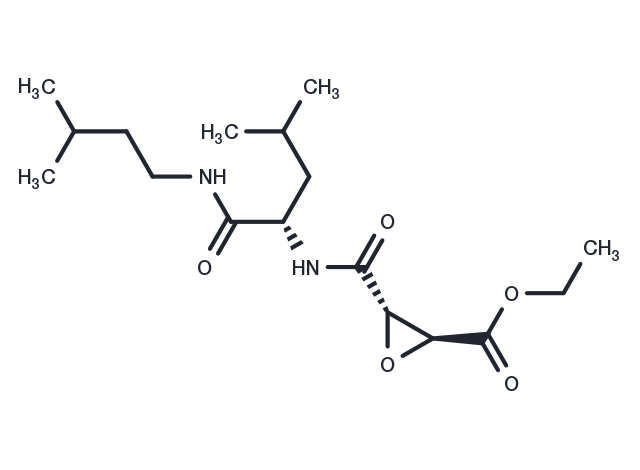Powder: -20°C for 3 years | In solvent: -80°C for 1 year


Aloxistatin (E64d) is an inhibitor of cysteine protease with blood platelet aggregation inhibiting activity. Aloxistatin is an irreversible, membrane-permeable inhibitor of lysosomal and cytosolic cysteine proteases with the ability to inhibit calpain activity in intact platelets.

| Pack Size | Availability | Price/USD | Quantity |
|---|---|---|---|
| 1 mg | In stock | $ 36.00 | |
| 2 mg | In stock | $ 51.00 | |
| 5 mg | In stock | $ 80.00 | |
| 10 mg | In stock | $ 122.00 | |
| 25 mg | In stock | $ 198.00 | |
| 50 mg | In stock | $ 369.00 | |
| 100 mg | In stock | $ 549.00 | |
| 500 mg | In stock | $ 1,190.00 | |
| 1 mL * 10 mM (in DMSO) | In stock | $ 64.00 |




| Description | Aloxistatin (E64d) is an inhibitor of cysteine protease with blood platelet aggregation inhibiting activity. Aloxistatin is an irreversible, membrane-permeable inhibitor of lysosomal and cytosolic cysteine proteases with the ability to inhibit calpain activity in intact platelets. |
| In vitro | Aloxistatin can enter the intact platelet and inhibit proteolysis by inhibiting calpain. [2] Aloxistatin blunts Parathyroid hormone (PTH)-induced cell proliferation and inhibits differentiation osteoblasts in vitro. [3] |
| In vivo | Aloxistatin (100 mg/kg, p.o.) strongly inhibits the cathepsin B&L activities in the skeletal muscle, heart and liver of hamsters. [1] In spinal cord injury (SCI) rats, Aloxistatin provides neuroprotection in SCI lesion and penumbra. [4] Aloxistatin reduces brain amyloid-β and improves memory deficits in Alzheimer's disease animal models by inhibiting cathepsin B activity. [5] |
| Kinase Assay | The CTLs and NK cells (0.8×106/mL) are treated with the inhibitors L1 (10-20 μM) or Aloxistatin (20-30 μM) for 24 hr at 37°C in 24-well plates. Cells are then used in 51Cr-release assays or are lysed to examine perforin in Western blots. The inhibitor is also added at the same concentration during the 4 hr reactions in some 51Cr-release assays, as indicated. Cell lysates are prepared using NP-40 lysis buffer (25 mM HEPES, 250 mM NaCl, 2.5 mM ethylenediaminetetraacetic acid, 0.1% volume/volume Nonidet P-40) and total protein concentration is determined using the Bradford assay. Equal amounts of protein are loaded and resolved on 8% SDS-PAGE gels. Human or mouse perforin is detected using the appropriate antibodies as indicated. Anti-actin antibody is used as a loading control[2]. |
| Cell Research | Aloxistatin (E64d) is dissolved in DMSO and stored, and then diluted with appropriate medium (final DMSO 0.1 %) before use[3]. Cell proliferation and apoptosis are assessed by staining for a proliferation marker, Ki67, or an apoptotic marker, cleaved caspase 3, following the protocol described above for the polarity markers. MCF10 variants are grown in 3D rBM overlay cultures for 4 days and are treated with 0.1 % DMSO, 5 μM CA074Me or 5 μM Aloxistatin. The percentage of structures that are positive for Ki67 or cleaved caspase 3 is determined by counting a total of 100 structures on two separate coverslips with a Zeiss Axiophot epifluorescent microscope. Structures are considered Ki67 positive if they contained at least one cell staining for Ki67. Structures are considered to be caspase 3 positive if they contained at least one cell that is positive for cleaved caspase 3 and the positive cell(s) is not localized in the center of a developing lumen[3]. |
| Synonyms | E64d, Loxistatin, E64c ethyl ester |
| Molecular Weight | 342.43 |
| Formula | C17H30N2O5 |
| CAS No. | 88321-09-9 |
Powder: -20°C for 3 years | In solvent: -80°C for 1 year
DMSO: 6.9 mg/mL (20 mM)
You can also refer to dose conversion for different animals. More
bottom
Please see Inhibitor Handling Instructions for more frequently ask questions. Topics include: how to prepare stock solutions, how to store products, and cautions on cell-based assays & animal experiments, etc.
Aloxistatin 88321-09-9 Microbiology/Virology Proteases/Proteasome Cysteine Protease SARS-CoV Cathepsin Inhibitor inhibit E64d Loxistatin E64c ethyl ester SARS coronavirus inhibitor
